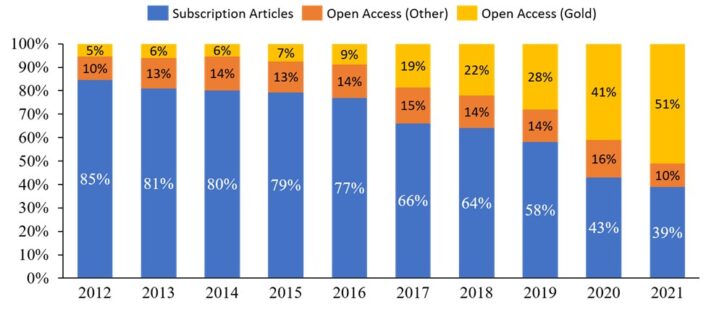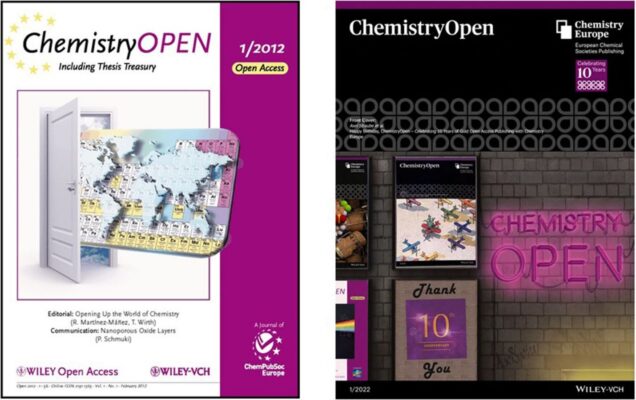One of the first Gold Open Access (OA) titles published by Wiley, ChemistryOpen, has turned 10 years old! We are celebrating this milestone by taking the opportunity to reflect on the role of Gold OA in the current STEM (science, technology, engineering, and mathematics) publishing landscape.
Although many Open Access titles such as ChemistryOpen are now firmly established within chemistry journals, there are still some open questions about this publishing model in the community. This article attempts to address some of these frequently asked questions. Read more on the 10th birthday of ChemistryOpen and the history of the first society-owned Open Access title in general chemistry, the other types of OA publishing models, what is behind the payment of Article Publication Charges (APCs), and how publishing Open Access benefits you and your audience.
Happy Birthday, ChemistryOpen!
In the first decade of the 21st century, the governments of a number of European countries recommended that all the research conducted with their funding be freely accessible for all readers, irrespective of socioeconomic or geographical considerations [1]. This development, in addition to the interest in being at the forefront of new publishing trends, prompted ChemPubSoc Europe – the predecessor of Chemistry Europe – to launch ChemistryOpen in 2011. Even so, the very first society-owned fully Open Access journal in general chemistry was very much an experiment. At that time, it was unclear whether Open Access would simply be a temporary trend in chemistry and to what degree it would be taken up in across the community.

Figure 1. Breakdown of manuscripts published in the Web of Science “Chemistry Multidisciplinary” category. The Open Access fraction is highlighted. Data taken from Clarivate Analytics Web of Science.
Since then, the public discussion around Open Access publishing has moved to the forefront, and the implementation of Open Science principles is now deemed essential by many. Funding bodies, researchers, publishers, and governments are in constant negotiation to find ways of meeting the needs of an increasingly open scientific world.
Meanwhile, the chemistry community’s demand for Open Access publishing has increased at a rapid rate. The year 2021 saw more than half of all research indexed in multidisciplinary chemistry journals published without a paywall, with a record 51 % of papers published with Gold Open Access models, freely available to all. Having really started accelerating five years ago, this trend shows no sign of slowing down (see Fig. 1).
A lot has happened since January 2012, when the first issue of ChemistryOpen was published. On the journal’s first front cover, the European societies and Wiley‐VCH highlighted this important first step by graphically unlocking the doors to open science (see Fig. 2).

Figure 2. The Front Cover of the very first issue of ChemistryOpen (January 2012) and the one celebrating the 10th anniversary of the journal (January 2022).
What Is Gold Open Access?
When we talk about “Open Access”, we are often specifically referring to the model to which ChemistryOpen adheres – Gold Open Access. This is the model whereby Article Processing Charges (APCs) are paid to cover publishing costs before the paper is made freely accessible to all readers, without them having to subscribe to the journal or to pay for the individual article.
Why Do I Have to Pay and What Do I Get for the APCs?
Added Value
High-quality publishing of reliable and ethically sound scientific content comes at a cost. The managing and resourcing of the publishing process include organizing and evaluating peer review, copy-editing (that is, checking manuscripts for accuracy and making minor language edits), typesetting and production (in both online and print media), and hosting of the content. When state-of-the art editorial software is employed and the highest ethical standards constantly ensured across a journal, a scientific publication is much more than just an online PDF file.
In the ChemistryOpen Editorial team and across the whole Chemistry Europe portfolio, all of our editors are trained chemists with doctorate degrees, and often post-doctoral experience, who work full-time on their journals. They are very experienced in meeting the adapting needs of authors and supporting them in publishing their research through a reliable, efficient, and personal process. Having your manuscript handled by a professional editorial team, with in-house or external editors, editorial assistants and technical staff, however, clearly comes at a cost.
Article Processing Charges (APCs)
While in the classic publishing model these costs are covered by a subscription to the entire content of a single journal or a whole journal portfolio of a publisher, in Open Access publishing, these costs are distributed at the article level through so-called Article Processing Charges (APCs). In this way, charges can be assigned individually and thus accommodate a wider diversity of authors.
Open Access publishing so aims to enable a more level playing field for researchers, regardless of where their research is being carried out. For instance, researchers from low-income countries listed by our partners at Research4Life do not pay any APCs for publishing in Gold OA journals, while retaining the right to reading the content of the entire portfolio in addition to the already freely available OA content. Additionally, for the Chemistry Europe society journals, a substantial part of the revenues is re-invested into the scientific community, with the portfolio owner chemical societies receiving annual payments from the OA surplus.
Copyright
An important, albeit often-overlooked, aspect of Gold OA publishing at journals like ChemistryOpen is that of copyright. Since the copyright for all versions of a Gold Open Access article stays with the authors, they themselves can do with the article as they please. Depending on the license the authors choose, other people may re-use the content when providing proper author attribution. Through the variety of licenses, Wiley offers authors full choice as to the extent of such re-use, for example, with regards to commercial re-purposing.
It is worth re-iterating that the editorial and peer review processes are exactly the same for Gold OA titles as for hybrid or subscription-only journals. In fact, many of our editors work for OA and hybrid titles at the same time. The APCs do not buy authors an easy paper – sometimes derogatively called „Pay to Publish“ – but are simply a redistribution of cost, while the added value of Open Access lies in full accessibility of the entire scientific content for all.
Who Will Pay My APCs?
An increasing number of funding bodies mandate that research they fund must be published in an Open Access journal. Many of these institutions and funding bodies also provide funds for covering the APCs, be it at the individual researcher level or by providing funds to institutions or consortia. Country-level transitional agreements, like DEAL for Germany, Jisc for the UK, or FinELib for Finland, combine access to research articles and Open Access publishing on large scales.
Unfortunately, the systematic funding of APCs is still far from being accessible and streamlined. There is no generally agreed cap for APCs, which can thus be independently determined by publishers, much as the subscription or article-level costs. High APCs, however, again create an unfair landscape with regards to who can pay and publish where. Where funding is available, the process of application and distribution of the funds is often complicated. The funding models often change and sometimes only apply to selected types of Open Access publishing (see below).
It will take time for this transition from subscription and hybrid to fully Open Access models to be completed. The process will involve efforts from all parties involved, including commercial publishers with their revenue expectations, researchers with limited funding options and with hopes for a transparent and fair pricing system, and funding agencies with their politically determined larger, long-term goals.
One example for such an interdependence is currently playing out for researchers based in Germany. Publishing Open Access and, specifically, in gold OA journals, is incentivized by a system of funding that increases with the number of articles published in the previous year, monitored by the Deutsche Forschungsgemeinschaft (DFG) and steered at the institutional level [2]. Based on existing funding, usually capped to exclude astronomically high APCs, the decision of which publishing model to choose is thus moving away from an individual, author-level choice.
What Else is There Beyond Gold OA?
In the current Open Access ecosystem, several OA models co-exist with Gold OA and usually refer to the specifics of “how” an article is made public. These models include Green, Bronze, and Diamond OA publishing, as well as Preprints.
Green Open Access Model & Preprints
Green Open Access, sometimes also called self-archiving, means that the authors deposit a version of their manuscript on a public platform, for example, an institutional or a subject-specific repository. This is always allowed if the manuscript has not already been submitted to a journal for their consideration; Preprint platforms such as ChemRxiv are specifically designed to help authors make their manuscript available at such an early stage, some even inviting other specialists to contribute to a public peer review process.
Chemistry Europe journals welcome articles that have been deposited on Preprint servers prior to submission to our journals.
Bronze Open Access Model
After the peer-review process at a journal is completed and the manuscript has been accepted, this accepted article, sometimes also termed a Postprint, depending on the publisher’s policy, cannot simply be shared anymore and the accepted article can only be made available on a public repository after an embargo period. The embargo period for most of the non-Gold OA Chemistry Europe journals, for example, lasts 12 months.
The Version of Record—the published article, copy-edited, and typeset in the publisher’s layout—cannot usually be shared publicly at all, unless the article has been published Open Access. In certain circumstances, publishers elect to make an article free to read for a certain period of time, as is currently the case for all articles relating to COVID-19 or for all researchers based in the Ukraine. This practice is sometimes referred to as Bronze Open Access.
Hybrid Open Access Model
An article can either be openly available or available through some sort of subscription, but not both. Therefore, Hybrid Open Access does not signify a “Schrödinger’s cat”-like situation but denominates a journal publishing both types of content.
While Green and Bronze OA do not generate costs for the authors, “hybrid” OA articles are currently often covered by transitional agreements, such as the well-known DEAL agreement between Wiley and German research institutions. Similar agreements have been made for other countries with a view to moving purely subscription-based journals towards an Open Access world.
Diamond Open Access Model
The last variant is the so-called Diamond (sometimes also Platinum) Open Access model. In Hybrid and Gold OA journals, APCs need to be paid – either by the authors, their funders, or through transitional agreements as we have previously discussed. Publishing in Diamond OA journals does not come with a visible price tag to the authors because the costs are covered in a different way; the owner society might waive the associated costs, the journal might be run as a non-profit organization by a dedicated team of scientists, or the journal might be cross-financed from other journals with the same publisher.
For a summary of the various Open Access models available to authors, see Table 1.
Table 1. The different Open Access publishing models.
| Model | Cost | Embargo/Time | Copyright | “True” Open Access[a] |
| Green | None for the preprint, postprint usually subscription-based | Yes, depending on the publisher | Preprint with the author, postprint with the journal | No |
| Bronze | Subscription-based | Time-limited | With the journal | No |
| Gold | APCs for the authors | No embargo period | With the authors | Yes |
| Diamond/Platinum | APCs covered through different model | No embargo period | With the authors | Yes |
[a] According to the Berlin Declaration of 2003 [3], relating to, among others, creative commons licensing.
Why Publish Open Access?
Given what we’ve already discussed in terms of Open Access publishing, why publish Open Access if it’s all so complicated and expensive? There is not one single reason that is most important for every case and there are definitely different angles to this question.
Accessibility
Recently, a strong drive towards Open Access has been evident, as exemplified by the 2021 UNESCO recommendation on Open Science [4,5]. A recent study by David Nicholas and co-workers has shown that, especially for early-career researchers, the question of making results freely available to everyone can be a moral one [6], and it is. For many scientists carrying out their research in the global south, accessing subscription-based journals or even just paywalled individual articles is unaffordable. However, those authors are also prevented from publishing Open Access because the sometimes astronomically high APCs serve as an unsurmountable barrier [7]. Organizations such as Research4Life are working towards changing that but are, unfortunately, not a permanent or all-encompassing solution and there are many who fall in the gaps between being covered by such agreements and yet still being unable to access the journal content because of financial restrictions.
The pressure the publishing system is under finds expressions in websites sharing pirated contents such as SciHub or LibGen which have appeared a decade ago, alongside the first major Gold OA initiatives by publishers [8]. While making the demand for freely accessible scientific content clear—when all content is publicly available, there is no need for piracy—these illegal sharing practices, uninvolved with maintaining any kind of standards or trust in the output of scientific publishing, should not be confused with Open Access.
Funding
Another often-stated concern lies in the nature of research funding – if research is publicly funded, should it not be publicly available? Along these lines, more and more funding agencies require that research they support financially must be published Open Access [9] and in some, albeit rare, cases, Gold OA publishing is even mandated [10]. These mandates are a big drive towards the adoption of OA models, despite some of them being met with resistance [11].
Open Access Publishing Works for You
Aside from the moral and funding point of view, publishing Open Access is also something that works for you. Your article will be available to everyone, attracting higher numbers of readers to your work compared to paywalled articles – that is, more people will engage with your work, leading to a wider dissemination, and, potentially, higher impact [12]. In addition, because you still hold the copyright to your own work, re-using it is simpler and not subject to approval of the respective publisher. By publishing in a Gold OA journal, you can help move mountains, re-shaping the landscape of academic publishing piece by piece.
References
[1] Francesca Rita Novara, A Golden Ten: A Decade of Open Access Society Publishing, ChemistryOpen 2022, 11, e202100270. https://doi.org/10.1002/open.202100270
[2] Funding Programme: “Open Access Publication Funding”, Deutsche Forschuingsgesellschaft (DFG), February 16, 2022. (accessed April 27, 2022)
[3] Max Planck Society, Berlin Declaration on Open Access to Knowledge in the Sciences and Humanities (accessed April 27, 2022)
[4] UNESCO Recommendation on Open Science, UNESCO November 2021. (accessed April 27, 2022)
[5] Marianne Bronner, Gerard Meijer, Vivian Yam, Bretislav Friedrich, UNESCO issues a powerful endorsement of Open Science, Natural Sciences 2022, 2, e10037. https://doi.org/10.1002/ntls.10037
[6] D. Nicholas, H. R. Hamali, E. Herman, J. Xu, C. Boukacem-Zeghmouri, A. Watkinson, B. Rodríguez-Bravo; A. Abrizah, M. Świgon, T. Polezhaeva, How Is Open Access Publishing Going down With Early Career Researchers? An International, Multi-Disciplinary Study, Prof. de la Inf. 2020, 29(6), e290614. https://doi.org/10.3145/epi.2020.nov.14
[7] Diana Kwon, Open-access publishing fees deter researchers in the global south, Nature 2022. https://doi.org/10.1038/d41586-022-00342-w
[8] Holly Else, Sci-Hub’s latest court battle means for research, Nature 2021, 600, 370-371. https://doi.org/10.1038/d41586-021-03659-0
[9] Registry of Open Access Repository Mandates and Policies (ROARMAP) website
[10] Christiaan van der Merwe, South Africa’s draft open science policy promises shake-up, ResearchProfession February 17, 2022. (accessed April 27, 2022)
[11] Vincent Lavrivière, Cassidy R. Sugimoto, Do authors comply when funders enforce open access to research?, Nature 2018, 562, 483-486. https://doi.org/10.1038/d41586-018-07101-w
[12] Helen Seymour, There are Clear Advantages When you Choose to Publish Open Access with Wiley, wiley.com March 25, 2022. (accessed April 27, 2022)




